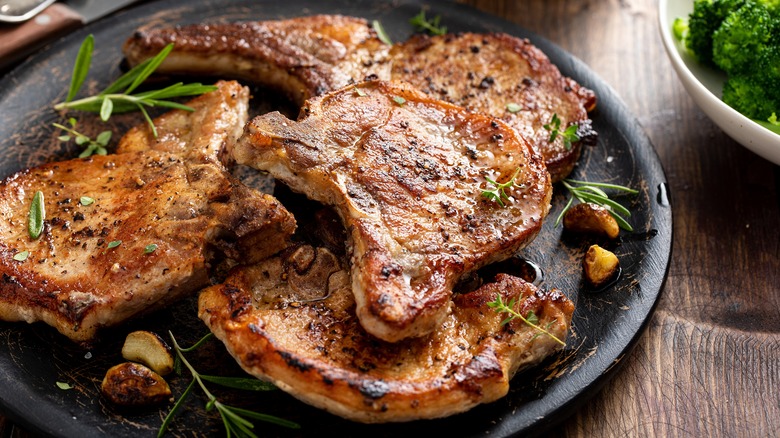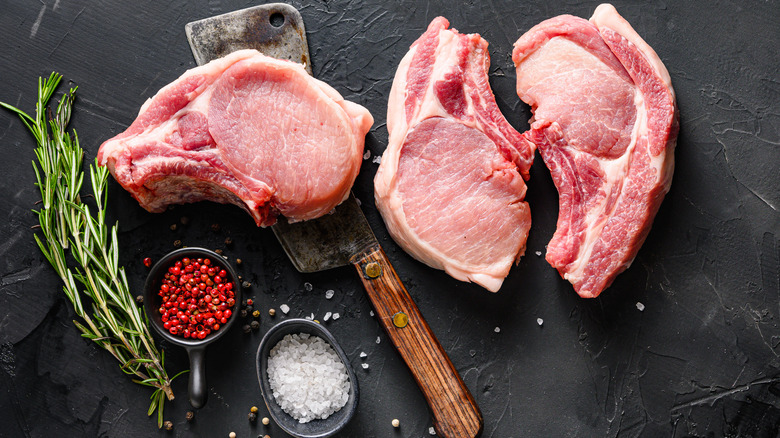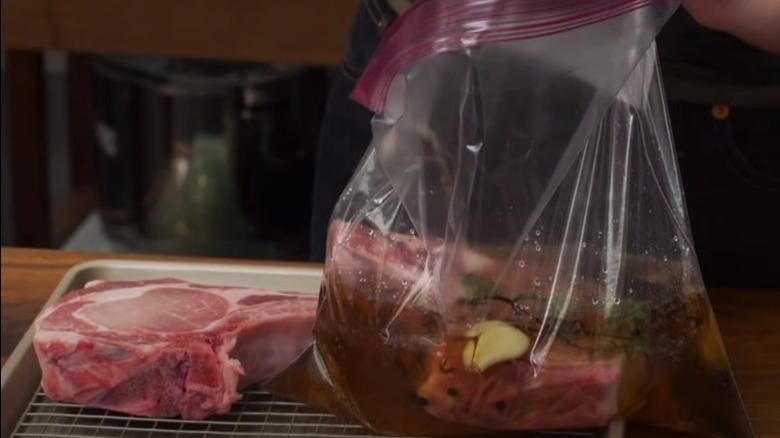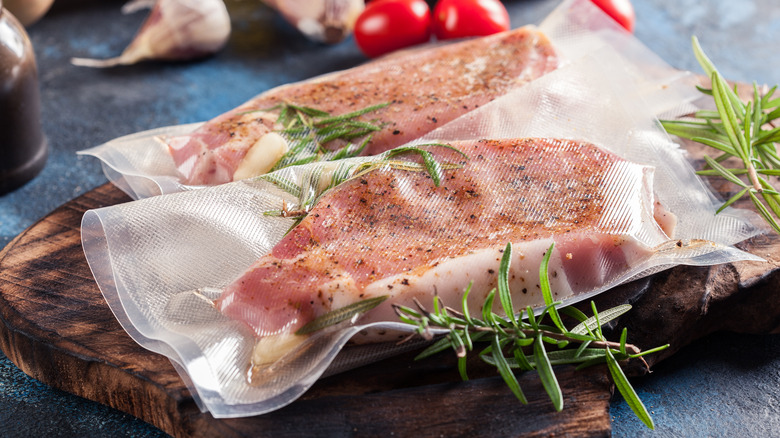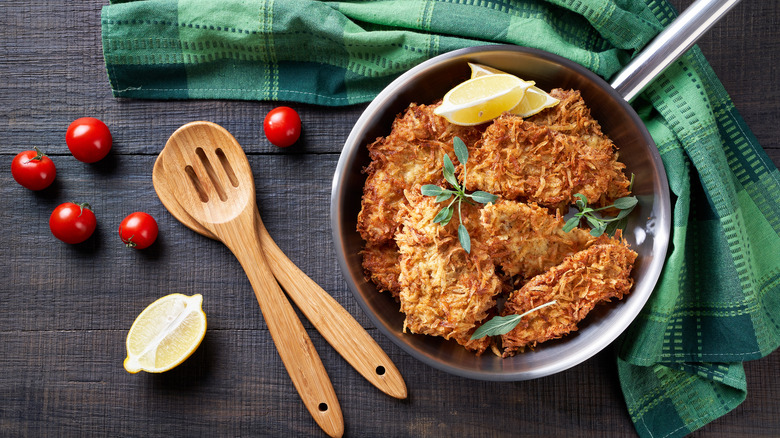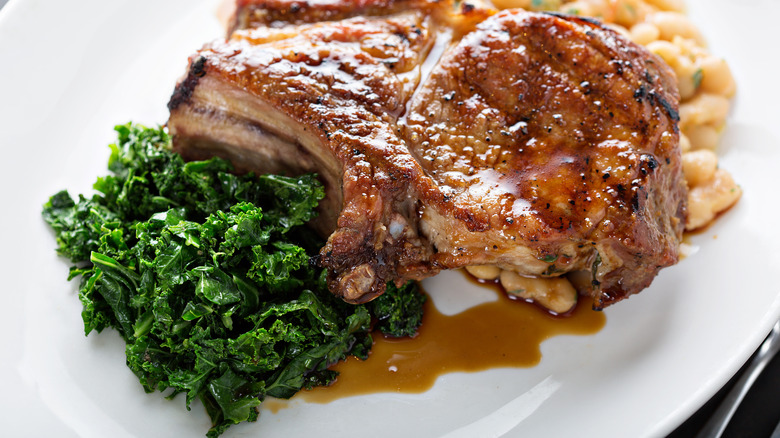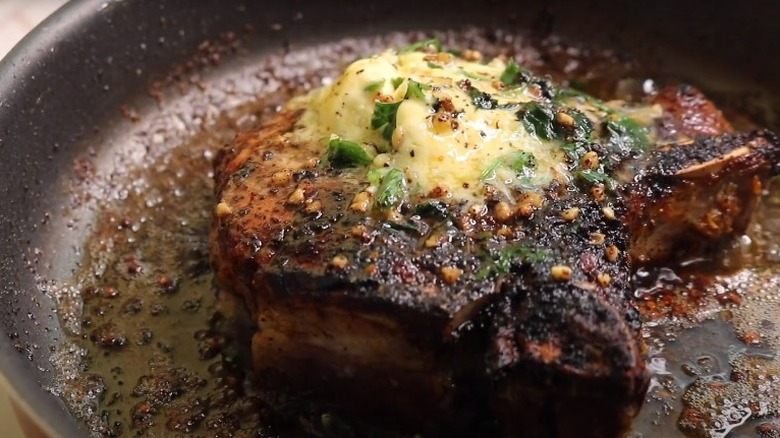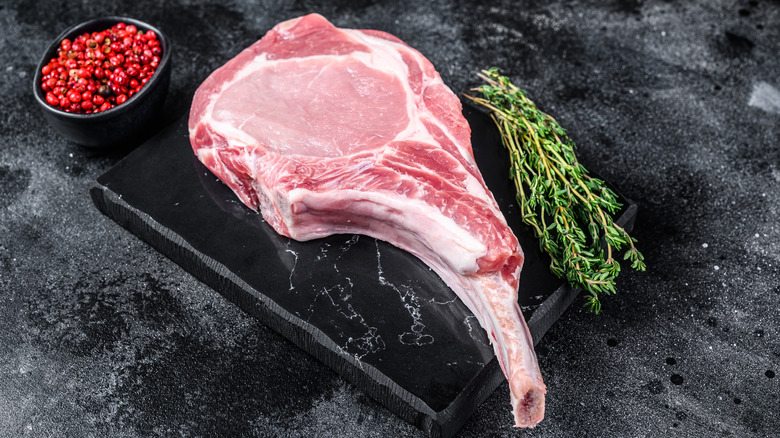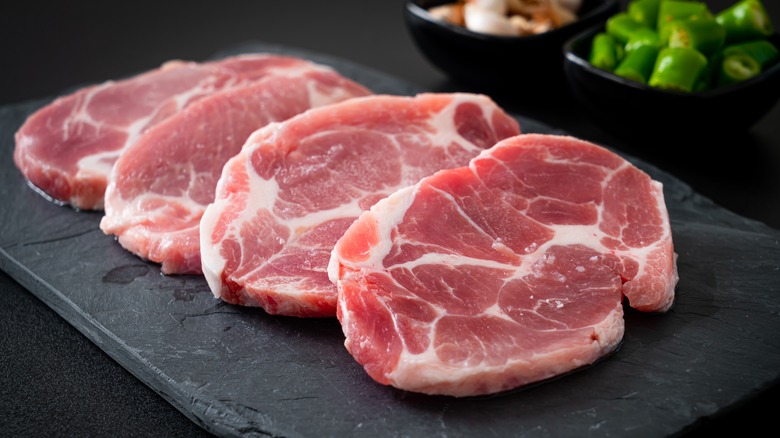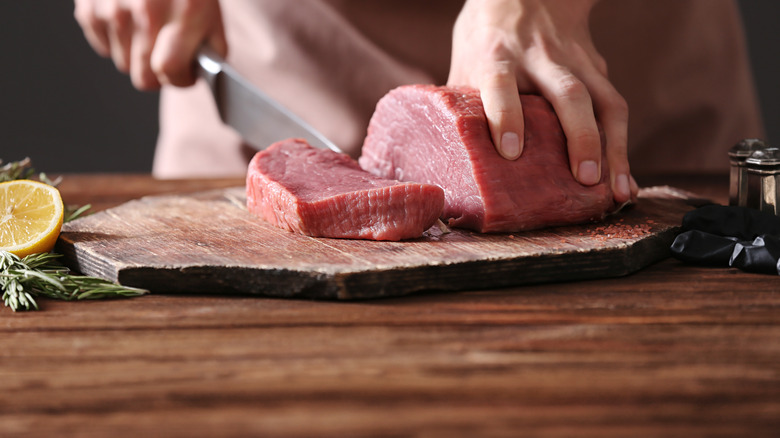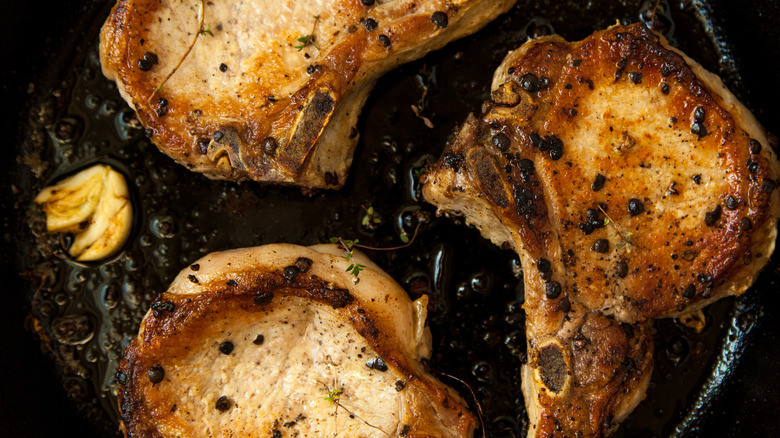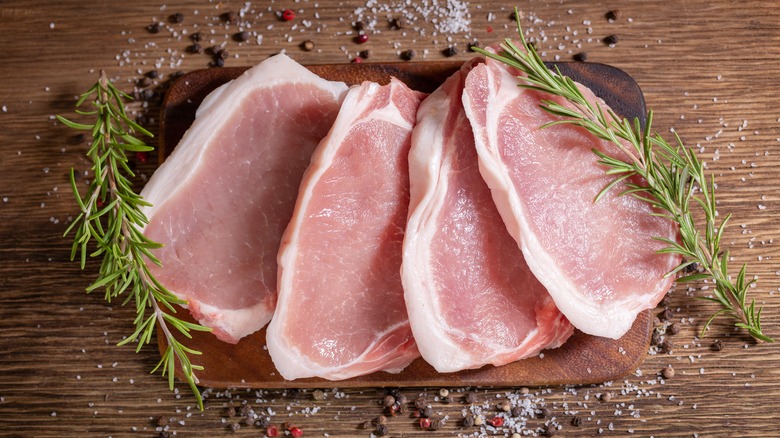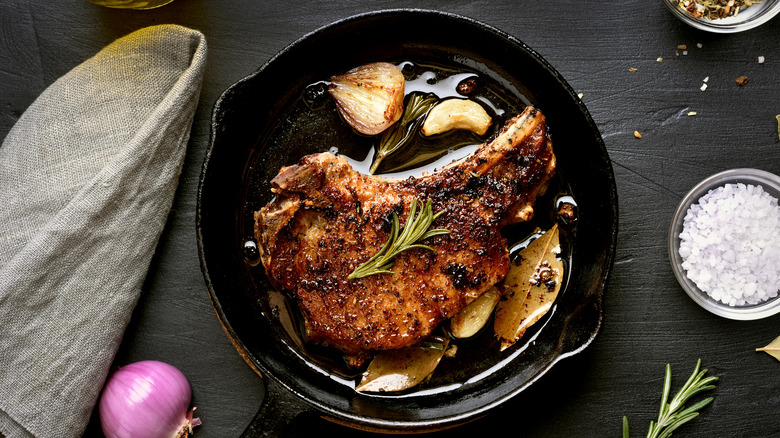Easy Tricks To Help Make Juicier Pork Chops
Pork chops make a delicious meal but can quickly go from delightful to disaster if they dry out. Many people have been turned off pork chops altogether because they've only had them prepared improperly, or at the very least, poorly. According to Essence of Yum, searching the internet for recipes will yield many options, but if you're looking for ways to make them juicy, you may end up down a rabbit hole with more questions than answers — and less confident than ever about what the best technique is.
The good news is there's more than one option to make this particular cut of pork so delightful you'll want to add it to your regular weekly rotation of meals. From choosing the proper cut of meat to preparing it in ways that will seal in all the juiciness and flavor to the right ways to cook them, we have all the tips and tricks you need to ensure your pork chops always turn out just the way you always hoped they would.
Choose the right cut
The simplest but most important thing you can do to ensure your pork chops turn out tender is to choose the proper cut. Didn't know there were different cuts of pork chops? You're not alone, but we're here to give you all the information you need to cook this protein. According to Premier Meat Company, pork rib chop is the most common and easiest to prepare. The cut contains the bone, crucial to creating a juicy pork chop. It is a T-shaped cut of pork from the center of the pork loin. This cut is usually served Frenched, meaning the end of the bone has been cleaned and is left exposed above the chop.
Other options to consider include the pork loin porterhouse. Cut from the hip section of the pork loin, this is a premium cut of pork, though it won't be as large as the porterhouse steak, which you're likely more familiar with. Pork shoulder chop is also likely to be juicy, but ensure you tenderize this cut first, as this meat section is tougher than other options. There are other options best suited to serve in stews like the sirloin chop or the boneless pork chop, a common choice but not the best option, which we will discuss later.
Pre-soak in brine
Soaking your pork chops before you cook them is a wonderful way to keep them juicy. As Mashed explains, a simple brine is nothing more than salt water, but you can add herbs and other seasonings to create a solution that not only tenderizes but also adds excellent flavor to your meat.
If you're looking for a basic option, you could add peppercorns and sugar, which will help balance out the saltiness of your brine. You can use any sugar or sweetener you like — white or brown sugar, honey, agave, or any other you can think of. Dissolve the salt and your chosen sweetener in the water in a pot over medium heat. Then, chill the brine and submerge your chops in it. They'll need to soak for four hours. You can leave them for less if you don't have that much time, but multiple tests reveal that is the best duration to make your pork chops juicy and tasty.
Another option for the sweetener in your brine is maple syrup. The syrup, combined with cinnamon, nutmeg, granulated onion, and vanilla, gives your pork a perfect fall flavor.
Cook them sous vide
Cooking pork chops sous vide is a wonderful way to end up with tender pork chops because it lets you regulate the temperature at which you cook the meat. The hotter and faster you cook them, the less tender they will be. A sous vide option may not give you the golden-brown color you are looking for on the exterior of your pork chops, but you can easily create that by finishing them off in the pan, according to Tasting Table.
You can add seasonings and butter directly to the package for a perfect pork chop every time. Tasting Table's recipe uses garlic, thyme, lemon peel, and olive oil to flavor your pork chop. Seal everything in a vacuum-packed bag and submerge it in the water. Cook for one hour at 140 degrees. Once they are out of the water, sear your pork chops in a skillet with more butter and a few extra thyme sprigs. Not only will this brown your chops, but it will also give the outside the crispiness you won't get if you only cook them sous vide.
Build a seasoning crust around your pork
Seasoning is an integral part of the process for several reasons, not the least of which is flavor. However, that crust of seasonings you're building up around your pork chop isn't just to make the meat less bland and create a better texture. It also helps seal in the juices that keep your meat tender. And it's easier to do than you think.
You don't need to add a ton of spices or seasonings to create a crust around your pork chops. You just need to create the right blend. Many rubs contain only three ingredients. As Tasting Table points out, you could use a single ingredient: salt.
And throwing in a bit of sugar never hurts. It will help caramelize your chops and enhance their flavor. It will also work to offset the saltiness. Need convincing? Consider how trendy (and delicious) salted caramel is. For even more flavor, consider brown sugar and paprika or pesto, parmesan, and panko, or any other spices that suit your fancy.
Add apple cider
Apple cider is an appealing way to make your pork chops juicy. The acids in the cider help tenderize the pork, creating a flavor that will make you want to add pork chops to your weekly menu. And as we just discussed, the sweetness in apple cider will help bring out the pork flavor.
Apple cider plays a crucial role in this recipe from Mashed that's easy to make and that everyone in your family will love. You will want to prepare things ahead of time since your garlic and thyme could burn quickly if your other ingredients aren't ready once your cider starts to reduce.
You'll need to bread and partially cook your chops first. Coat them in flour, salt, and pepper and cook in a deep skillet with a high smoke point oil. How long you need to cook them will be determined by the thickness of your chops. Thinner chops will only need about 10 minutes, while thicker ones may need as much as 15. Set aside your cooked chops, then add butter, shallots, and garlic to your skillet. Brown them, then deglaze your skillet with the cider. As it begins to simmer, return your pork to the pan, tuck some thyme sprigs in with it, and add heavy cream. Remove the thyme sprigs before serving.
Try a dry rub and top with butter
What you put on your pork chops is as crucial to how juicy they turn out as how you cook them. We've already talked about some of the tips in this recipe for Dry Rubbed Porterhouse Pork Chops with Steakhouse Butter. It uses the porterhouse cut, a dry rub, and slathers seasoned butter on top, similar to how a porterhouse steak is prepared.
The first part of this recipe you'll need to prepare is the butter because it needs time to chill before use. Melt two tablespoons of butter in a skillet and add garlic, shallots, and salt. Cook until the shallots are soft, then pour the seasoned butter into a bowl and let it cool. Once your melted butter has cooled, add six more tablespoons of butter, parsley, lemon juice, white pepper, Worcestershire, and thyme. Mix until well blended, make a butter log on a sheet of wax paper, and put it in the fridge to firm.
The dry rub for this is a multipart version. Use chili powder, cilantro, sugar, salt, ground pepper, and granulated onion. Rub this seasoning mix on your pork and let sit for 15 minutes. Cook over medium heat for four to five minutes per side. Slice your butter log and put a slab of seasoned butter on top of each porterhouse chop before serving.
Buy bone-in options
Choosing boneless pork chops is a mistake many people make because they think they are easier to work with. As Market House explains, there are benefits to selecting boneless options. Among them is convenience. No additional prep is necessary since the fat has already been trimmed. This means they are a leaner and healthier option as well. And they will cook more quickly.
However, bone-in chops are not only less expensive, but they are also tastier. The same added fat that gives them extra flavor also makes them less likely to dry out when you cook them. They also have a more classic appearance. When you picture restaurant pork chops, they are typically served with the bone in.
Choosing bone-in pork chops doesn't have to mean higher fat and calories or more difficult preparation. You can sear and then oven-bake them in just 20 to 25 minutes (via Diethood). Start by searing your pork for three to six minutes while your oven preheats. Season with paprika, onion powder, and herbs before adding it to the skillet. Top them with melted garlic butter and bake at 375 degrees for 12 to 15 minutes, basting with more butter about halfway through.
Let it rest
You should let your pork chops rest before and after cooking if you want them to turn out tender. Chefworks explains that one of the common mistakes people make when cooking pork chops is moving them right from the refrigerator to the cooking surface. When you do this, the outside of your pork cooks much faster than the inside. This could lead to a charred exterior by the time your pork chop has cooked through.
Let your pork chops come to room temperature before cooking. Take them out of the fridge 20 to 30 minutes before you're ready to start cooking them. This will bring your pork to a consistent temperature that allows it to cook evenly.
Wrapping your pork after you cook it also has several benefits (per Rackz BBQ). Letting the meat rest after you cook it helps kill any germs and eliminate food-borne illnesses. It also helps with the moisture of the meat, and since we're aiming for juicy pork chops, this is essential. In addition, cutting into your meat as soon as it comes off the heat releases moisture from inside the musculature of the protein, which can make it taste drier than it should. Letting it rest lets this water redistribute through the meat, so it is juicy when you eat it. If you wrap your meats after they cook, it will also help the meat retain moisture and create a superior flavor.
Tenderize with lemon juice
Lemon makes a delicious tenderizer. Everyday Health explains that the citrus fruit's acidic properties help break down the muscle fibers in your meat, creating a juicy, tender pork chop. An added benefit is that it also helps flavor your meat. It can even replace salt in many recipes, making it ideal for those with high blood pressure.
You'll want to be careful not to use too much lemon, as it could have the reverse effect (via India Times). Lemon works by drawing moisture out of the meat before you cook it. Letting it tenderize for an hour is ideal. Leave it longer and you could draw out too much water, leaving your pork chops tough and tasteless.
You don't have to use just lemon. This technique works best if you mix the lemon juice into a marinade. Consider combining it with canola oil, garlic, onion, and ground pepper (per Genesis Medical Scheme). One more benefit of this? Breaking down the muscle fiber coils in your meat can reduce cooking time, reducing exposure to potentially cancer-causing chemicals created by excessive heat.
Use oil for cooking and butter to season
We've already discussed how butter-basting your pork chops can help flavor and tenderize the meat post-cooking. However, it isn't something you should use for cooking. Tasting Table recommends cooking in oil before butter, preferably with a high smoke point. Grapeseed or rice bran oils work well. Alternatively, you could cook your pork chops in pork fat. This will amp up the pork flavor and give the exterior a golden-brown color.
Once you've seared your pork in oil, finish it with butter. That will add to the flavor and help wrap up the cooking process. In addition to seasoning the pork, you can add herbs and seasoning to your butter. Aim for complementary herbs if you're seasoning your butter and pork chops. Both will flavor your pork chops, but you don't want them to clash. Sage and thyme are delightful traditional seasoning options. If you're looking for something less common, consider Thai basil and mint.
Don't trim the fat
Not only are fattier pork chops tastier, but they're also juicier. Too many people trim the fat off their pork chops, wanting them to be a leaner meat option. According to Tasting Table, this may date back to a '90s advertising campaign that labeled pork as "the other white meat." Those advertisements might also be why it's more challenging to find fat-marbled pieces of pork at your supermarket.
If you find a nicely marbled piece of pork, avoid trimming all the fat from it, as it will make for dry, less flavorful chops. You also don't want to leave too much fat, especially if you plan to cook your pork chops on the grill. Leaving too much fat on your pork could lead to dangerous flare-ups. Trim the fat to about ¼ of an inch if grilling. This is enough to keep your pork juicy while preventing excess grease and oils from dripping onto your gas or coals.
Cook in cast iron
Our last tip involves what cookware to use and how long to cook the meat, which are crucial factors in preparing a juicy pork chop. According to Tasting Table, cast iron is the way to go. Why? Because it distributes heat evenly, which is necessary when searing pork. The size of your pan also matters. If it is too small and your pork chops are crowded, they won't sear properly, and you want that golden crust on the exterior of your meat. For two pork chops, you need a 12-inch pan.
Searing is a relatively fast process. This is important because overcooking your meat will dry it out. The center of your pork chops should be pink when they are finished cooking. If you learned to cook in the '80s and '90s, this is likely contrary to everything you were told.
Until 2011, food-borne illnesses, trichinosis specifically, were a risk factor for rarer pork, and the USDA recommended cooking to an internal temperature of 160 degrees (via Lacademie). The new standard is 145 degrees. Studies have shown the Trichinella parasite is killed at temperatures of 137 degrees or higher. If you cook your meat to 145 degrees and let it rest, its final temperature should be around 155 degrees, more than high enough to eliminate the risk without drying out your pork.
